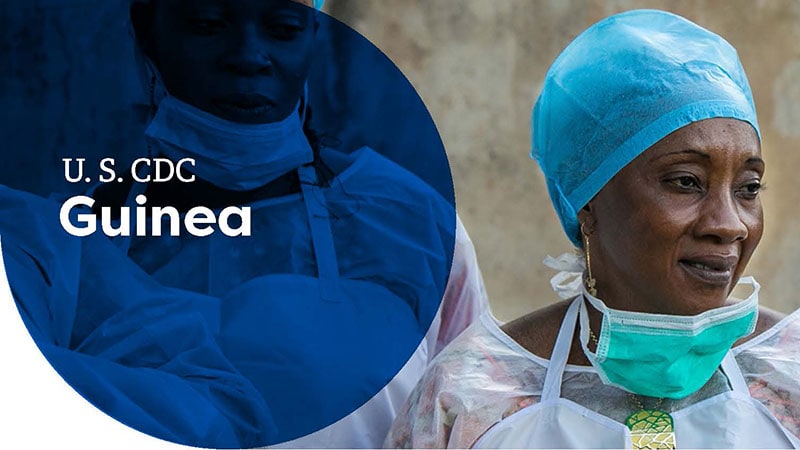At a glance
CDC established an office in Guinea in 2015 during the Ebola outbreak in West Africa to help strengthen capacities to prevent, detect, and respond to public health threats.

Overview

CDC Guinea works closely with the Ministry of Health (MOH) and other partners in Guinea to address the following public health areas:
- Health systems strengthening
- Workforce development
- Laboratory systems
- Emergency management
- Malaria
- Ebola
Global health security
Strategic focus
CDC's global health security work in Guinea focuses on strengthening the country’s public health systems across the following core areas:
Health systems strengthening
CDC began facilitating the District Health Information Software 2 (DHIS2) in 2015 to manage routine and epidemic-prone disease surveillance data and rapidly detect disease outbreaks in Guinea. CDC and partners developed standardized data collection tools that include updated case notification forms and combined case data from clinical and laboratory sources. These tools are integrated into the DHIS2 system.
CDC and the African Epidemiology Network (AFENET) also supported the MOH to incorporate COVID-19 and Ebola modules into DHIS2 and train public health workers to use the system. In 2019, CDC transitioned community-based disease surveillance activities over to the MOH. CDC continues to support DHIS2 trainings for health facility staff and community health workers across all 38 Guinean districts.
Workforce development
Guinea's Field Epidemiology Training Program (FETP) was established in 2016 to strengthen workforce capacity to investigate and respond to disease outbreaks. Two levels of training— intermediate and frontline—help national, regional, and local public health systems stop outbreaks before they become epidemics. FETP-Advanced trainees complete the program in neighboring Burkina Faso. FETP graduates have led key management, case and outbreak investigations, and disease surveillance activities for COVID-19 and Ebola.
Laboratory systems strengthening
CDC collaborates with the MOH’s national laboratory and regional laboratories to strengthen diagnostic systems for priority diseases. CDC has provided equipment, reagents, and training to increase testing capacity for meningitis, cholera, shigellosis, and brucellosis in two regional laboratories in Labe and Kankan. In collaboration with the MOH, International Medical Corps, and Georgetown University, CDC also supported the development and implementation of a national specimen referral policy.
Emergency management
CDC helped establish Guinea’s first public health Emergency Operations Center (EOC) in 2015. The national EOC is an integral part of the MOH’s National Agency for Health Security, which has now established an EOC in each of Guinea’s 38 districts. In addition to responding to disease outbreaks, district EOCs also support polio, tetanus, and measles vaccination campaigns.
During the COVID-19 pandemic, CDC supported several activities including:
- Disease surveillance
- Border health
- Infection prevention and control
- Case investigation and management
- Laboratory testing and reporting
- Risk communication and community engagement
- Vaccination
Key accomplishments
- CDC, AFENET, and the MOH trained over 12,000 health workers to use the DHIS2 for routine and epidemiological surveillance.
- The software is now used at laboratories and national and district health departments across all 38 Guinean districts.
- The software is now used at laboratories and national and district health departments across all 38 Guinean districts.
- Country EOCs have coordinated outbreak responses for COVID-19, Ebola, yellow fever, measles, Lassa fever, Marburg virus disease, and vaccine-derived polio.
- Since 2016, over 300 public health workers have completed Guinea's FETPs.
- 17 Guineans have graduated from Burkina Faso's FETP-Advanced.
- 17 Guineans have graduated from Burkina Faso's FETP-Advanced.
Malaria
Strategic focus
Guinea’s entire population of 12 million people is at risk of malaria. Under the U.S. President's Malaria Initiative (PMI), CDC assigned a resident advisor to Guinea to support malaria prevention and control. CDC engages with USAID in several key prevention and disease control activities including:
- Increasing access to mosquito nets
- Indoor residual spraying
- Preventing malaria in pregnancy
- Enhancing diagnostics and case management
- Vector control and resistance monitoring
- Providing seasonal chemoprevention to children
Key achievements
Since 2017, CDC's support through PMI has helped deliver:
- Nearly 8 million bed nets
- Nearly 4 million malaria preventive treatments in pregnancy
- Over 13 million fast acting malaria medicines
- Nearly 14 million rapid diagnostic tests
Ebola
From 2014-2016, Guinea experienced the largest and most complex outbreak of Ebola in global history. The epidemic started in Guinea and spread to several other countries, including Sierra Leone and Liberia. CDC deployed over 300 staff to respond to Ebola in Guinea. CDC assisted the MOH and World Health Organization with:
- Epidemiology and disease surveillance
- Contact tracing and data management
- Infection prevention and control
- Laboratory strengthening
- Quality assurance
- Border health
- Emergency management
- Communication
CDC's continued support since 2014 played an important role in Guinea's increased capacity to rapidly contain the 2021 Ebola outbreak. Local health workers continue to systematically use rapid tests to confirm whether any deaths are due to Ebola in areas that recently experienced cases or outbreaks. CDC continues to support development and implementation of vaccination strategies to prevent future Ebola outbreaks.
Key achievements
To quickly respond and control the 2021 outbreak, CDC helped deploy 1,500 Ebola rapid tests and train 100 health workers from five districts in the N'Zerekore region. CDC also deployed scientific and technical experts to respond alongside partners and CDC country office staff. CDC provided on-the-ground technical assistance to all parts of the responses, including:
- Epidemiology and surveillance
- Laboratory
- Infection prevention and control
- Case management
- Border health
- Risk communication and community engagement
- Vaccine
- Survivor programs

